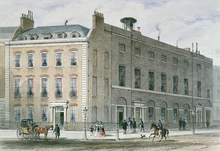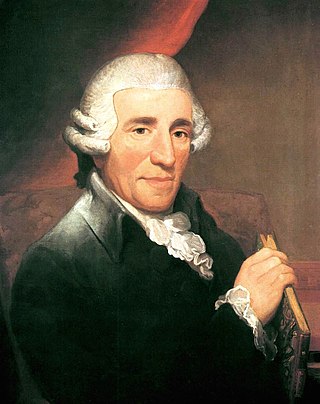
Franz Joseph Haydn was an Austrian composer of the Classical period. He was instrumental in the development of chamber music such as the string quartet and piano trio. His contributions to musical form have led him to be called "Father of the Symphony" and "Father of the String quartet".
Johann Evangelist Haydn was a tenor singer of the classical era; the younger brother of the composers Joseph Haydn and Michael Haydn. He was often called "Hansl", a diminutive form of "Johann".

Symphony No. 22 in E♭ major, Hoboken I/22, is a symphony written by Joseph Haydn in 1764, under the auspices of the benign Prince Nikolaus Esterházy. Its nickname is "The Philosopher".

The House of Esterházy, also spelled Eszterházy, is a Hungarian noble family with origins in the Middle Ages. From the 17th century, the Esterházys were the greatest landowner magnates of the Kingdom of Hungary, during the time that it was part of the Habsburg monarchy and later Austria-Hungary. During the history of the Habsburg Empire, the Esterházy family were consistently loyal to the Habsburg rulers. The Esterházys received the title of Graf (Count) in 1626, and the Forchtenstein line received the title of Fürst (Prince) from the Holy Roman Emperor in 1712.
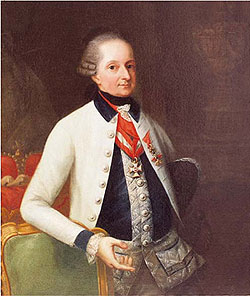
Nikolaus I, Prince Esterházy was a Hungarian prince, a member of the famous Esterházy family. His building of palaces, extravagant clothing, and taste for opera and other grand musical productions led to his being given the title "the Magnificent". He is remembered as the principal employer of the composer Joseph Haydn.

Eszterháza is a palace in Fertőd, Hungary, built by Prince Nikolaus Esterházy. Sometimes called the "Hungarian Versailles", it is Hungary's grandest Rococo edifice. It was the home of Joseph Haydn and his orchestra from 1766 to 1790.

The composers Wolfgang Amadeus Mozart (1756–1791) and Joseph Haydn (1732–1809) were friends. Their relationship is not very well documented, but the evidence that they enjoyed each other's company is strong. Six string quartets by Mozart are dedicated to Haydn.
Maria Anna Sabina (von) Genzinger, called Marianne, was a Viennese amateur musician, the mother of six children, and a friend of the composer Joseph Haydn. Her correspondence with Haydn preserves a personal view of the composer not available from any other biographical source. Her daughter Josepa was a singer who gave the first performance of Haydn's Ariadne auf Naxos.
Luigia Polzelli was an Italian mezzo-soprano, who sang at the Esterházy court in Hungary during the late 18th century. She was for a number of years the lover of the composer Joseph Haydn.
Gregor Joseph Werner was an Austrian composer of the Baroque period, best known as the predecessor of Joseph Haydn as the Kapellmeister of the Hungarian Esterházy family. Few of Werner's works survive to the present day, and he is mostly remembered for his troubled relationship with Haydn.
Mathias Haydn was the father of two famous composers, Joseph and Michael Haydn. He worked as a wheelwright in the Austrian village of Rohrau, where he also served as Marktrichter, an office akin to village mayor.

Count Karl Joseph of Morzin (1717–1783) was a Bohemian aristocrat from the Morzin family, remembered today as the first person to employ the composer Joseph Haydn as his Kapellmeister, or music director. The first few of Haydn's many symphonies were written for the Count.

Joseph Haydn's Symphony No. 31 in D major, Hob. I/31, was composed in 1765 for Haydn's patron Nikolaus Esterházy. It is nicknamed the "Hornsignal Symphony", because it gives a prominent role to an unusually large horn section of four players. Probably because of its prominent obbligato writing for the horns, in Paris, the publisher Sieber published this symphony as a "symphonie concertante" around 1785.

The skull of composer Joseph Haydn was stolen shortly after his death in 1809. The perpetrators were identified, but went unpunished. The skull was kept separate from the rest of Haydn's remains for a period of about 145 years.

The Symphony No. 18 in G major, Hoboken I/18, is a symphony by Joseph Haydn. The composition date is conspicuously uncertain. The Breitkopf catalogue entry assures that it was composed no later than March 1766, the date of the Esterhazy orchestra moving to Esterhaza, but most scholars believe it was composed at least a few years before then. Dates between 1757 and 1764 have been also suggested but not proven.
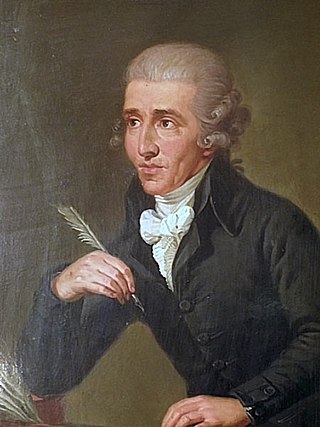
The Autobiographical sketch (1776) of Joseph Haydn is the only autobiographical document that was ever prepared by this composer. Haydn wrote the sketch, which is about two pages long, when he was 44 at the request, relayed to him by a chain of two mutual acquaintances, of Ignaz de Luca, who was preparing a volume of brief biographies of Austrian luminaries, Das gelehrte Oesterreich. The sketch was published in 1778, in Volume 1, Part 3 of that work.

Ludwig Guttenbrunn was an artist who worked in the latter part of the 18th century and early 19th century. He was born in the Holy Roman Empire and died in the Austrian Empire. He specialized in portraiture and history painting.

Anton (Antal), Prince Esterházy de Galántha was a prince of Hungary, a member of the wealthy Esterházy family. He is primarily known for his patronage on composer Joseph Haydn.
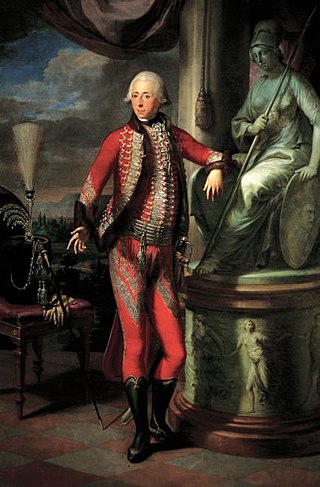
Nicholas II, Prince Esterházy was a Hungarian prince. He served the Austrian Empire and was a member of the famous Esterházy family. He is especially remembered for his art collection and for his role as the last patron of Joseph Haydn.
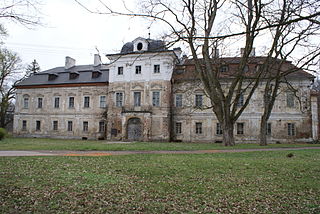
The Morzin Palace is a country estate in Dolní Lukavice, Czech Republic.







